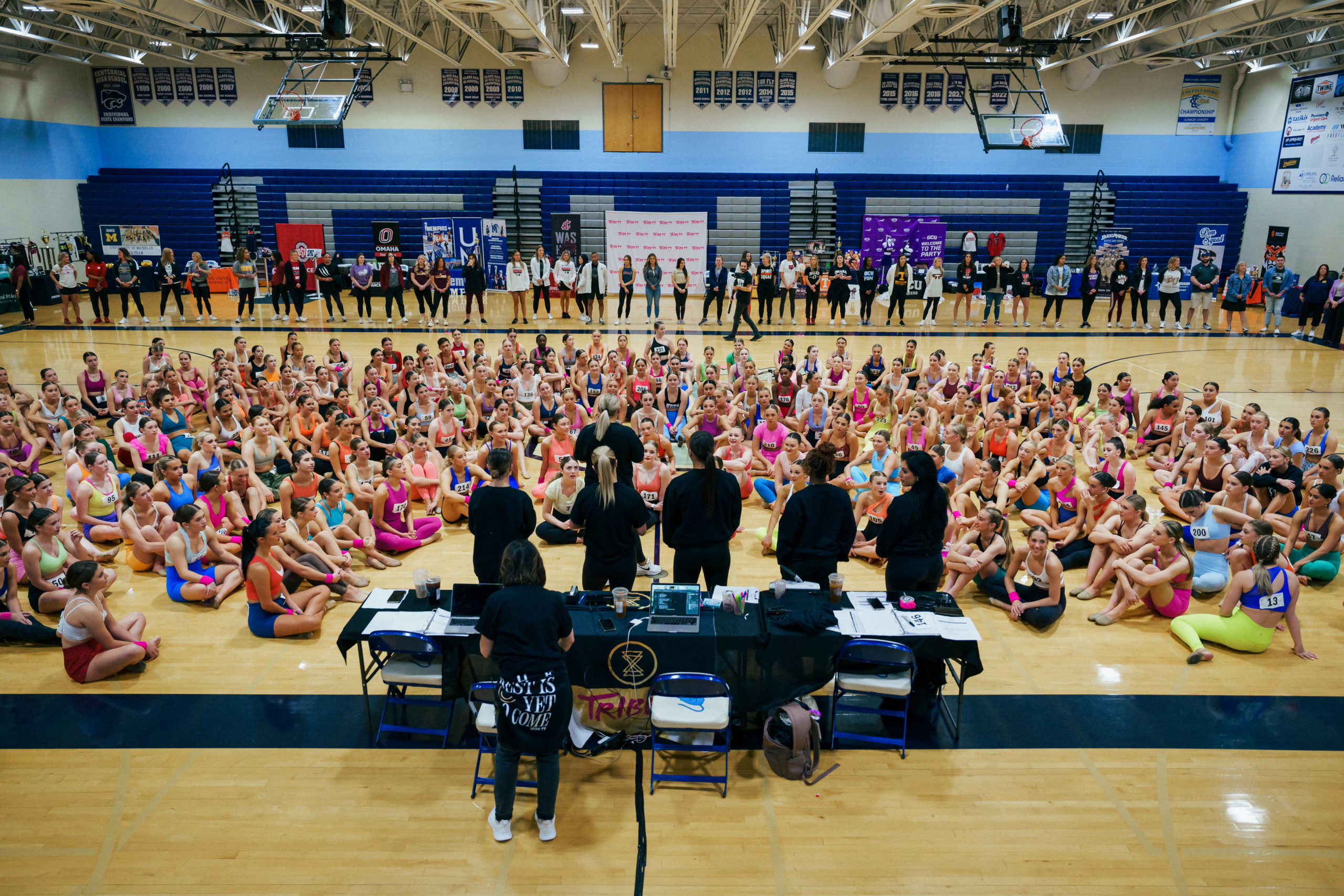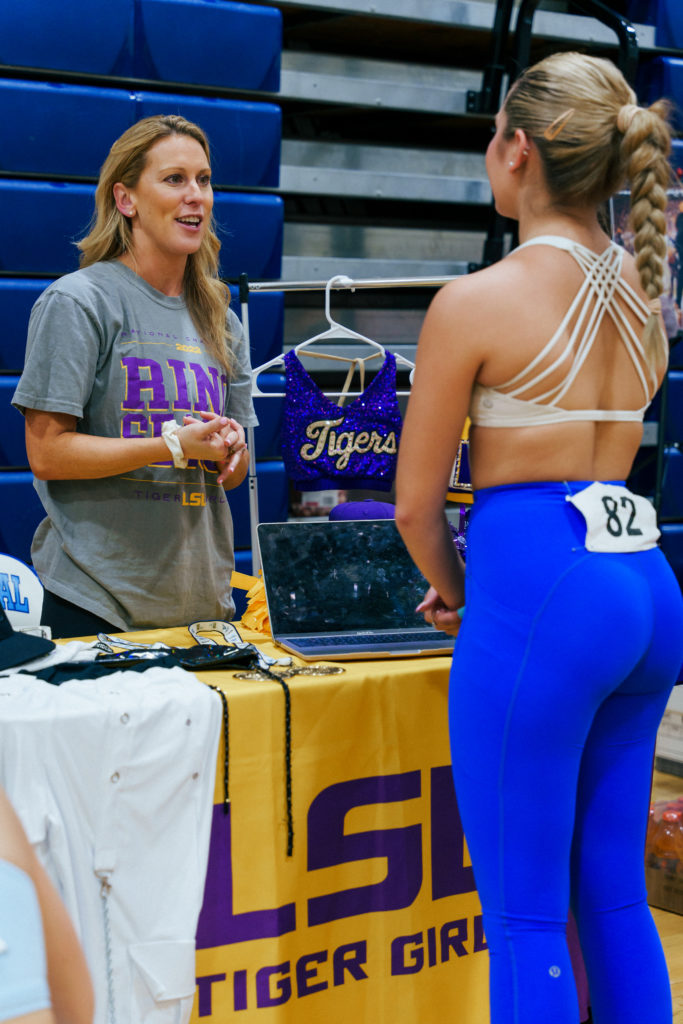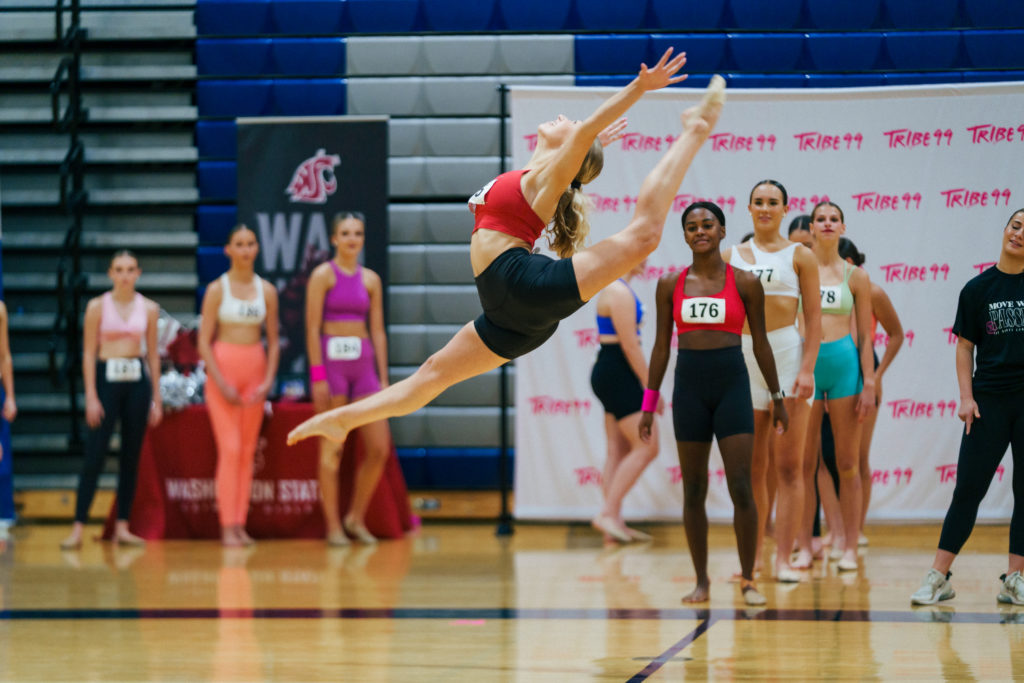
For many dance teachers and coaches, there comes a time when your students tell you they are interested in pursuing dance beyond high school. For some, this means pursuing a university dance major, auditioning for a dance company, or entering the commercial dance industry. But for others, auditioning for a collegiate dance team is the next step.
To prepare students interested in joining a college dance team, it’s important to become familiar with the audition process. Over the past few years, there has been a shift from the traditional audition process—usually involving an open audition every spring in which dancers either make or don’t make the team based on their performance of skills and routines during the audition—to a recruiting model—a typically more involved process, in which coaches seek out prospective dancers from a series of recruiting events, video submissions and interviews, eventually hand-picking their team and offering spots.
The Ohio State Dance Team was one of the first to make this shift, adopting a recruiting-only model for the selection of their 2019–20 team. More recently, dance teams from schools such as Florida State University, Washington State University, the University of Tennessee and many others have followed suit.

Recruitment can be rigorous and stressful for dancers, and as with any audition process, dance teachers and coaches play important roles as mentors and supporters. Here are steps you can take to help your dancers navigate the recruiting process more smoothly.
Have Conversations Early On
While most deadlines for entering the recruitment process range between early fall and winter of a dancer’s senior year in high school, college coaches recommend getting involved earlier rather than later.
According to Ohio State Dance Team head coach Melissa McGhee, sending your dancers to clinics as early as freshman and sophomore years is beneficial, because it gives them an understanding of what the collegiate dance team space looks like. By the spring of junior year, students should have a solid understanding of what the recruiting process entails for the teams they are interested in.
FSU Golden Girls coach Chasity Tyus, whose team shifted to recruiting for the 2022–23 season, also recommends having more serious conversations with your students by their junior year about which programs they are interested in, and encouraging them to attend clinics and reach out to coaches.

Emphasize Exposure
One way dancers can get coaches to notice and remember them is by attending clinics and recruiting events. “A confined environment, where coaches are literally attending the event to seek out dancers—is your highest chance for exposure,” McGhee says. “So, I can certainly support and attest to being at camps, and clinics, or combines, and finding people and then pursuing them from there.”
After seeing gaps in the industry and a shift in recruiting, TRIBE 99 founder and CEO Carsen Rowe started recruiting events like The Dance Combine and The Expo, to provide a central space for high school dancers to connect with many college coaches at once and maximize their exposure. TRIBE 99’s events, and similar events like the UDA and NDA combines, usually entail a day or weekend of learning routines, speaking with and performing in front of college coaches, and more. “This could be the one event that might really accelerate you and your platform and be kind of like the diving board into your full exposure into the college dance realm,” Rowe says.
If dancers aren’t able to attend bigger recruiting events due to financial or other reasons, however, Tyus assures that there are still other opportunities to get exposure. For Ohio State, McGhee states that dancers are welcome to send in links to solo videos or highlight reels at any time. And Rowe recommends dancers utilize social media by tagging teams and building their online dance resumés.
Help Your Dancers Stay Organized
To help minimize stress, Rowe suggests helping your dancers create a calendar to keep track of paperwork and video submission deadlines, as well as dates of important clinics and recruiting events.
“Managing the deadlines and the details of the recruiting process is a lot,” McGhee says. “But as long as you’re organized and managing that process regularly, it should be workable and manageable. But it’s never a good first impression if you’ve missed a deadline and are asking for an exception.”

Provide Strategic, Balanced Training
Rowe recommends developing specific training plans by actively researching what skills teams are requiring and performing in their sidelines and Nationals routines. She emphasizes training well-rounded dancers who have a solid foundation in the three styles college dance teams perform most—jazz, pom and hip hop. She also suggests spending a dancer’s sophomore and junior years working on weaker areas, so they can be the most well-rounded version of themselves by senior year.
Movement and performance quality are also important to work on. “I think a lot of high school dancers are like, ‘But I can do 10 pirouettes with perfect technique,’ and it’s like, ‘Yes, you can, my dear,’ but it’s the performance and the quality of movement. I feel like when you’re trying to seek a top collegiate program, the deciding factor a lot of times is your ability to really dance and move people,” says Rowe.
Go Deeper Than Dance
As much as college coaches are looking for dancers with great technique and movement quality, they are also looking for ambassadors and well-rounded student athletes. Tyus wants to see dancers’ personalities, not just their dance ability, and Rowe adds that consistency of character is crucial in the recruiting process.
Another important aspect to consider is academics. McGhee believes teachers and coaches can help guide students to do college research from a more holistic perspective. “Heaven forbid if someone gets injured and they can’t dance for a year—are they still going to be happy? And that’s only going to be a yes if they’ve done the research on the front end to ensure that the school is a fit, the academic standard and major is a fit, the resources provided by the team is a fit—and then dance.”
Be Honest and Transparent

Have honest conversations with your students about which programs might be best for them based on their abilities and interests and what is potentially in and out of reach. “I think as a coach and as a dance teacher, we owe it to the [students] to have those conversations, but also train them to be able to go to those schools they really want to go to,” says Tyus.
With college coaches, McGhee says being a reliable recommendation source is very important because they will often reach out to high school dance teachers and coaches to ask about a dancer’s character, work ethic and more. For dancers interested in multiple teams, Tyus says to be honest with coaches about dancers’ intentions because most college coaches know each other and communicate.
Provide Support, but Don’t Take Over
Rowe admits that a mistake she often sees in the recruiting circuit is studio owners, coaches and parents not understanding their role in the process, where they take over versus only being involved to a degree that is necessary. McGhee agrees and adds that student athletes should be driving the communication, with dance teachers and coaches being a secondary point of communication. It’s important to give support, but let your dancer take charge of their own recruiting journey.
Encourage Positivity, Patience and Open-Mindedness
Despite the overwhelming nature of recruitment, Tyus reminds dancers to have fun and not put too much pressure on themselves. Teams only have a handful of open spots each year, so even being considered is a big deal. If rejection occurs, encourage your dancers to stay positive, keep pushing and shift their focus.
McGhee also suggests reminding dancers to be patient and keep their options open: “There are a lot of factors behind the scenes for college coaches as they figure out roster limitations, team needs, geographic needs and all of that. There are so many variables that go into the process that it’s not always the best dancer that selected—it’s the best fit.”
Amidst the various unknowns of college dance team recruitment, being a strong support system for your dancer is important. And providing the help, training, honesty and encouragement they need can help them find the best fit for them.





